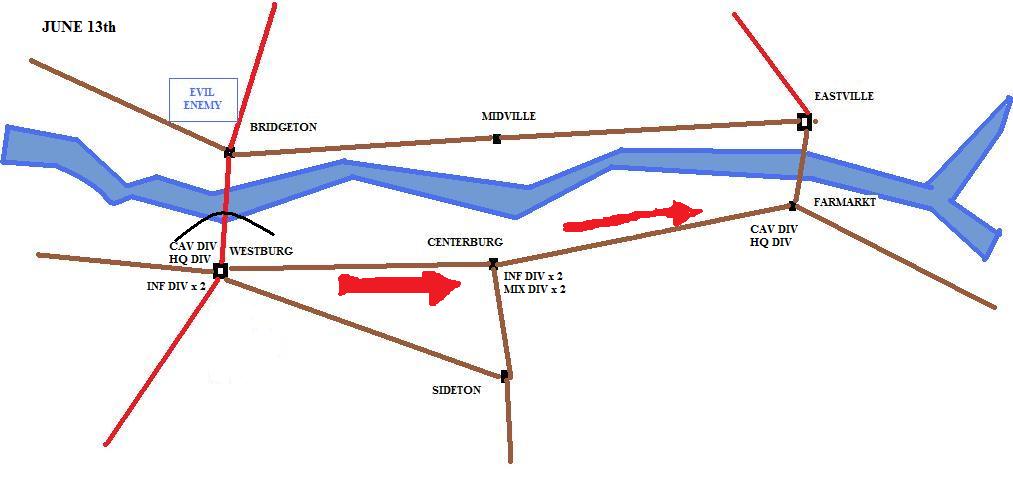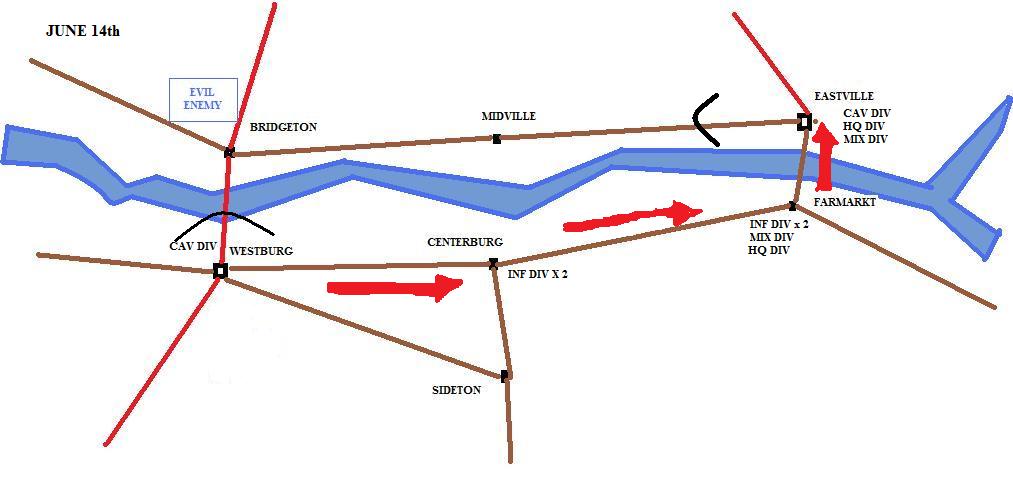
MOVEMENT
Each leg on the map represents a day's normal march for infantry. Cavalry can make two moves and Headquarters can choose to move as much as three. Also, force marching makes it possible to move an additional leg but may fatigue units.
Movement is done either by giving orders to units or when they retreat from battle. Retreats are only ever one leg.
Movement orders must abide by the 'rule of three' but by specifying an intermediate destination, a unit could be ordered up to 6 legs distant.
Road Limitations
Every division, including headquarters (they have baggage and artillery) occupies a place on a road. There is a limit on how many divisions can move down a road on a given day (including retreats). Major Roads can accommodate 10 units, Minor Roads 6. If the Road crosses a river, that limit is halved. Using the rule of three, if a unit is ordered to travel to a destination and the shortest route is blocked by other units using the road, it will look for another route to that city. Historically, Wing and Army commanders would work out detailed schedules and routes for every division to take every day to get maximum efficiency out of the roads.
Road Priority
Troops move in order of priority (from 1 to 4, 1 going first). The default priority is 1 for mixed divisions, 2 for infantry, 3 for cavalry, and 4 for headquarters. You can adjust the priorities for each order as needed. If you were to order your entire wing forward down a single road without specifying road travel priorities, you might find all of your Corps and Wing Headquarters travelling two days behind your lead columns and so if they get into a battle, your divisions would all be fighting without Corps or Army commanders. You can imagine how that would work in Napoleon's Battles terms.

Let us say that on June 12th, the listed forces are at Westburg and they are each ordered to move to Farmarkt because their commander has a scheme to outflank the enemy that are assembled at Bridgeton. As first priority, The two Mixed Divisions move direct to Centerburg. As second Priority, the 4 infantry divisions follow along to Centerburg and that means that the Westburg-Centerburg road has now reached its road capacity of 6. No more forces can use that road today.
The third priority is the cavalry. With its orders to get to Centerburg, it finds that it can get there via Sideton. So they will move twice, being cavalry, and arrive at Centerburg along with the other divisions.
At fourth priority, we look at headquarters movement. When moving headquarters, you can choose to move 1, 2 or 3 legs.
If they were ordered to move 1 they would move to Sideton and stop. If 2, they'd join the rest of their forces at Centerburg. If they were ordered to move 3 then the two HQ divisions would move to Sideton and then Centerburg and then on to Farmarkt.
On the next day, the 14th, The infantry and mixed divisions would move to Farmarkt, clog up the road, and your cavalry and any HQs behin would sit idle for the day. They would follow along on the 15th. So, although cavalry can move 2 legs per day, it would take them three days to get from Westburg to Farmarkt, a distance of 2.

Note that if they had tried to push everyone north across to Bridgeton, 2 mixed and 3 infantry divisions would have crossed on the first day. The next day there might be a battle (if the attacking troops did not decide to fall back) and up to 5 more units could arrive as reinforcements at various times during the day.
So what is another way to do this flanking manoeuvre?
First, on June 12th, order one cavalry division at Westburg to not move but to place cavalry piquets toward Bridgeton. This will prevent the enemy from seeing that you abandoned that position. Next, on the 12th, order 2 infantry divisions, 2 mixed divisions, a cav div, and a HQ to move to Eastville (with the HQ moving at speed 2. Tell the cavalry that is moving to put up piquets toward Midville.They will all move on the 13th.

On the 13th, while those other divisions are moving, you order the two remaining infantry divisions to move to Eastville.If you wished to, you could force march them but your army's bottleneck is going to be the bridge to Eastville where only 3 divisions can cross each day so there's no sense pushing your men just to wait at the bridgehead. You also may want to plant your wing HQ division at Farmarkt. This will better allow you to pass orders instantly to your divisions there and so allow you to control neatly the passage of troops in the order you want them.
If you ordered one of the mixed divisions to force march, they could be the third unit across the Eastville bridge on the 13th. The cavalry, when it arrives at Eastville, will automatically deploy its skirmish screen toward Midville. The enemy won't know what is about to hit them.

On the 14th, you can consider ordering your Westburg cavalry screen in. Keep in mind that you should allow a day for the courier to get to them. All of your other troops, with orders to march to Eastville, won't need to be told to do anything differently. By the end of the 15th you'll have 6 divisions across the river and 9 by the end of the 16th.
It needs to be said though that before doing any part of a manoeuvre such as this, the commander should remember to check his lines of communication to ensure that they will accommodate this shift of center and perhaps change some of his Corps centers of communications.
SINGLE ROAD CONTINUOUS COLUMN MOVEMENT
When ordering a Corps to move, the default choice is Single Road Continuous Column (which may not be the ideal method for your current situation). This type of movement has some very particular mechanics:
One non-HQ division is selected as the lead division. The default choice, where available, is a mixed division. This division is given priority 1 for movement.
If the lead division shares a location with the Corps HQ, the lead division will advance one leg toward its goal. If it does not then it will not move. Therefore, the Corps will move in an accordion style with the lead division always waiting for the HQ to catch up. Note, this assumes therefore that the HQ is always set as priority 4 and so the HQ will always be the last unit moving in the Corps.
For each non-leading unit in the Corps, it will look to see if the leading unit is adjacent to it and if so, will move to where the lead unit is (assuming that there is room on the road). It will NOT check for other routes but will instead simply wait.
In the case where a unit loses track of its lead unit (it is two or more cities apart), it will abandon the continuous road column and just use the best route that it can find to reach its destination. Note that this method of movement can get messed up if you have the leading unit being a unit that can move 2 spaces per day and the following unit only move 1. likewise, the column can get broken up by differing forced march rates if you try to force march it.